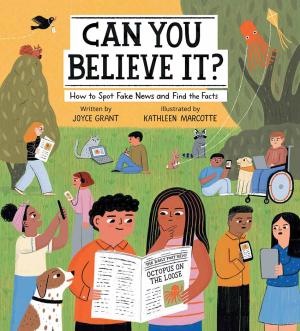
Can You Believe It? How to Spot Fake News and Find the Facts
Freelance journalist Joyce Grant’s Can You Believe It? thoroughly informs the reader about fake news. The non-fiction text is divided into six concise chapters that explain what fake news is, why fake news exists and how to identify it. Each page includes informative text along with excellent visuals by Kathleen Marcotte, which inspire rich discussions. Prompts and examples encourage readers to think critically and apply what they are learning.
This book is a suitable read-aloud or reference text for Junior grades or higher (grades 4+). Some concepts, such as clickbait, propaganda and deepfake, are perhaps more appropriate for the middle-school level.
In language studies, this book can help facilitate a complete fake news unit. Students can be introduced to the concept, practise strategies to identify fake news and then work on a creative writing assignment where they create their own fake news. It can also be referenced to encourage deep, critical thinking and to teach students topic-specific terminology. A unit like this can cover reading, writing and media literacy expectations. The book can also be used to teach research skills and how to identify reliable sources when completing projects for social studies and science. In math, statistics and data about fake news sources can be analyzed and interpreted.
Can You Believe It? is nicely laid out with a well-organized table of contents, making it easy for students to read or for teachers to use as a mentor text. Every page uses vibrant colours, images and relatable examples to engage the reader. A list of trustworthy websites and games at the end of the book can be used by teachers and students to further their understanding of fake news.
Overall, this is a must-have resource for school bookshelves, bringing awareness and teaching kids to think critically about social media and fake news.
Manprit Rai is a member of the Peel Teacher Local.